#Sewing Machines
Explore tagged Tumblr posts
Text
How Not to Break Your Sewing Machine
I work in a shop where we repair sewing machines (a LOT of sewing machines), and unsurprisingly we see a lot of the same problems over and over again, so I'm here with some advice on how to keep your machine running longer.

When you break a needle, dig around until you have found the broken piece. If you leave it in there, it can end up in the wrong place at the wrong time and break something vital.
SLOW DOWN. The function of your sewing machine depends on the different moving parts ending up in the right place at the right time. Having to go through a lot of/heavy material slows the needle down, but it doesn't slow down the mechanism underneath the needle plate. If you try to go your usual speed, the needle will arrive too late and collide with something it shouldn't, breaking either the needle or the bobbin case. If the material is especially heavy (say you're sewing several layers of denim, or sewing webbing onto canvas), take your foot off the pedal and turn the machine by hand.
Clean out the bobbin area after each project. Really. Your machine comes with a little brush for this purpose. If it doesn't, a little dollar-store paint brush will work just fine. Remember what I said above about things being in the right place at the right time? Everything needs to be able to move freely for this to work. I know it looks like it's just a little dust and fluff, but it will jam up your machine eventually.
If you can, get your timing adjusted by a professional. I know most people don't have a sewing machine repair shop in their neighbourhood, but if you can do this, it's worth it. If the machine's timing is good, then you're more likely to have a little leeway for heavier fabric or a lintier bobbin case. When the timing is just a bit off, it takes less of an obstacle to put the needle in a place it shouldn't be.
If you can, buy a machine built before 1980. If it's still working 50 years after it was made, it's gonna keep working. Those older machines are made with metal gears and therefore weigh a ton, so they're definitely not a good choice if you don't have a permanent setup for your machine, but it means they basically last forever. Newer machines are made with plastic parts, and no matter what you do, they will break.
Don't buy a Singer Heavy Duty. I'm sure those machines have their benefits, but they are absolutely not heavy duty. We repair more Singer Heavy Dutys than any other single model of sewing machine. If you're already stuck with a Heavy Duty, then follow my advice above even more scrupulously, and start shopping around for a replacement if you can. You can get a used sewing machine of better quality for significantly less than a new Heavy Duty.
To keep things working properly, make sure you're:
threading your machine properly
using the right kind of bobbin
adjusting your tension properly
and using the right kind of needle for the fabric you're sewing!
(These things are unlikely to break your machine, but they will keep it from sewing properly.)
Other than that, get your hands on your machine's manual and read it carefully. If you can, bring your machine in for a cleaning and adjustment now and then. Your machine will need repairs every once in a while: it's a lot of little moving parts! But these are some basic precautions you can take to avoid some common problems.
#sewing machines#sewing#sewblr#sewing machine#i imagine most of you already know this stuff#but many of our customers do not#sewing machine psa#sewing machine maintenance
8K notes
·
View notes
Text
Please stop tagging me in that foolish sewing machine diagram, it's been floating around the internet for many many years and I've seen it before multiple times and I simply do not find it funny. It's just a bunch of random words slapped on there.
#complaining#sewing machines#they call a round thing a cube and a post that does not spin a spinny thing. where's the joke? it's all just random crap.#It's old enough that I can at least forgive whoever made it for the ha**y po***r references...#if you do find it funny that's fine! I just think it's dumb and unfunny#also I don't normally reblog anything to this blog so if you're going to tag me in something just tag my main blog
119 notes
·
View notes
Photo
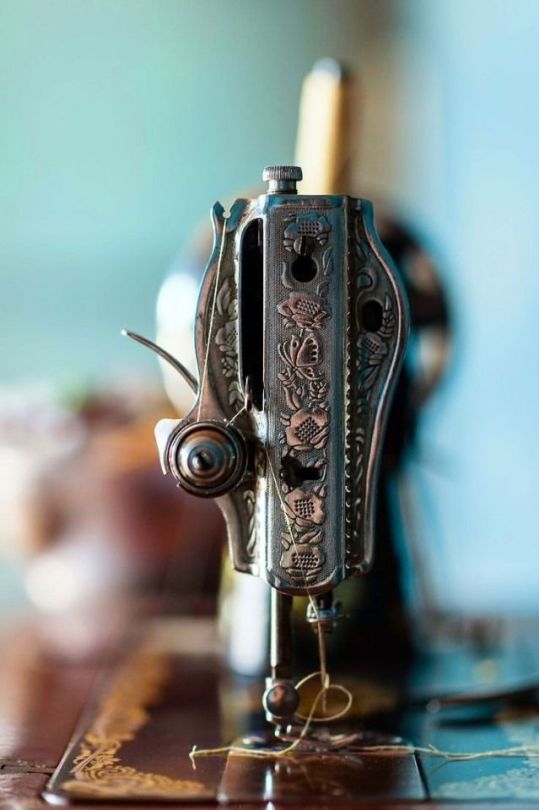
~ Aqua and Bronze ~
206 notes
·
View notes
Text
I am begging people to stop buying this damn sewing machine for anyone older than 12.
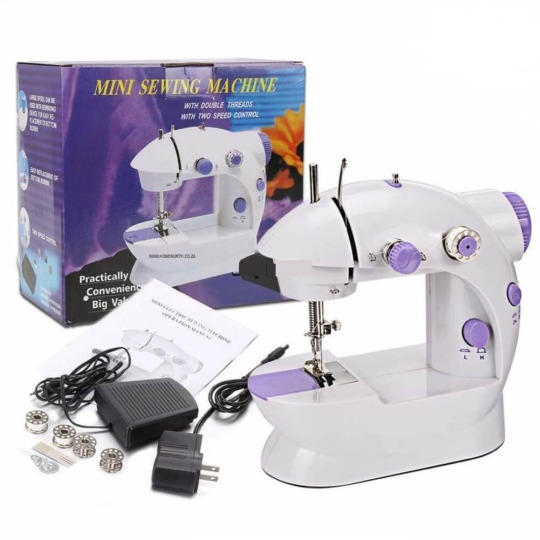
As a toy for children, it's acceptable. If you ACTUALLY want to sew something, do not get a cheap piece of crap from Walmart for $35!! You'll work on this thing for 15 minutes, it will suck, you will get frustrated, and then you'll tell yourself that you are simply incapable of sewing and that it's too complicated for you. But it's not your fault-- you are working with a child's toy. That's like giving up on driving a car because your Barbie Jeep's battery dies the first 5 minutes you're in it.
My two recommendations:
First and most recommended: You get a LIGHTLY USED modern plastic machine for cheap off Facebook Marketplace or your local sewing machine repair shop. I'm talking less than 10 years old. You ask the seller "do you use this regularly" or "has this been serviced". Try to buy from someone who has used the machine recently because they'll know its ins-and-outs. You can find a modern machine for like $30 on Facebook Marketplace from someone who has actually used it (I would not recommend Goodwill or anywhere you can't speak to the person who used it before you, if you are just starting out). One highly recommended modern machine for beginners is the Singer Heavy Duty.
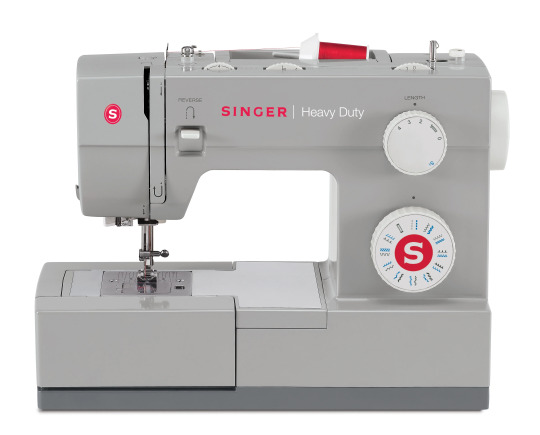
It's $200 new but you can easily find one much cheaper used. It's simple to use and will hold up to basic sewing for the time it will take you to decide whether you want to sew or not. Other modern Singers suck ass; save yourself the trouble. Go with the Singer Heavy Duty or a Brother, or even a Janome if you can find one cheap enough. Stay away from anything that's not a time-trusted brand.
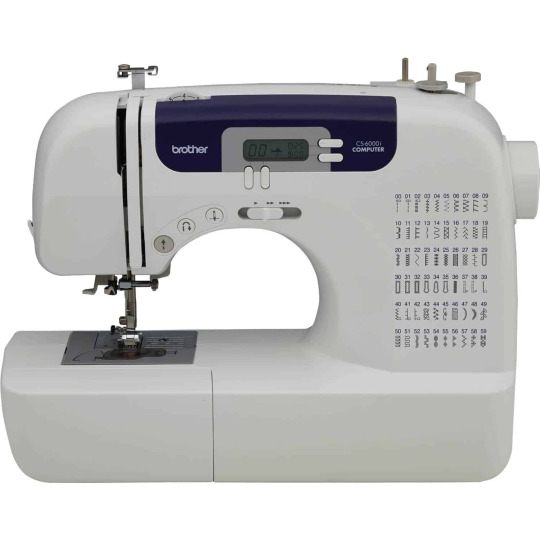
The Brother CS6000i is a decent beginner's machine.
Again, do not buy machines off eBay unless they make it CLEAR that it has been fully serviced and is in perfect working condition. They honestly aren't much cheaper used on eBay than they are new, so best to buy it from someone on Facebook Marketplace or at a sewing machine repair place.
Second recommendation: Buy a VINTAGE METAL machine that has been fully serviced or in perfect working condition. These are more difficult to find serviced, so I wouldn't recommend it unless you find one on FB Marketplace (though the one I got on eBay worked perfectly out of the box). There will be TONS of very cheap vintage machines on FB Marketplace, but the problem with these is that they've often been sitting in a cabinet for 20 years, unused. Not great for learning on. You can also buy one of these machines and have it serviced, but having a machine serviced will cost more than the machine is worth, more often than not.
There are benefits to a vintage metal machine over a modern plastic one. it will last your lifetime. It can sew through thick, difficult fabrics. They're much better looking imo. They likely won't break unless you drop them down a stairwell. However, the oldest ones only do a straight stitch, and speaking as someone who has vintage and a modern machine... the automatic buttonholer and overlock stitch are nice to have! But the vast majority of the stitching you will do will only be zig zag (for stretch knits/elastic) or straight stitch. The zig zag feature became available in most domestic sewing machines by the late 1950s.
Any vintage machine made before 1970 will be fine to sew with; everything was pretty good quality back then. 1970s era Kenmores are ugly and basic but they are cheap while also being excellent machines, and they're the "newest" domestic machine you can get that's still all metal.
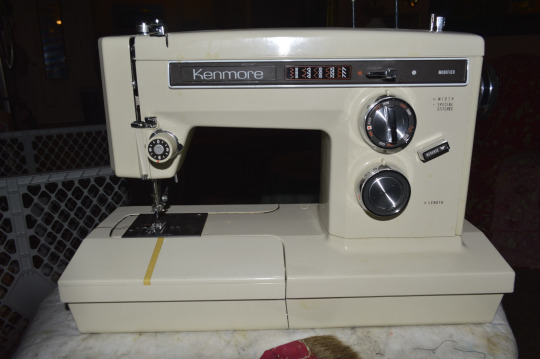
Any Singer will have easy-to-replace parts, have easily findable user manuals, and every sewing machine repairman will be able to fix them. The uglier ones in the 1960s are dirt cheap, if you make sure it's not younger than the 628 or 337. Both of these machines are the cheapest vintage all-metal Singers you'll find and they work fine (and they do zig zag stitches).
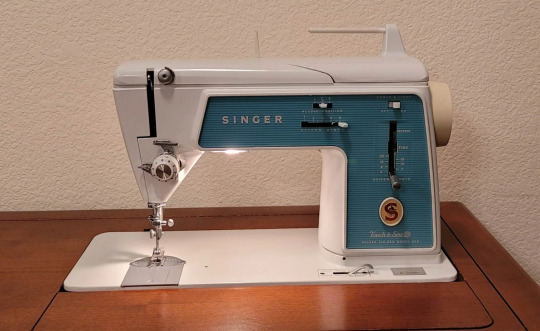
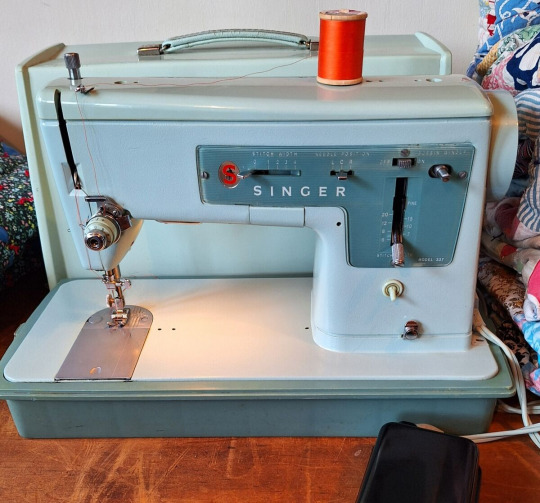
Do NOT get a Touch n Sew or Stylist made in the late 1960s or later. Generally if it has plastic buttons, it's got something plastic inside (not always, but with Singers, often). These Golden Touch n Sews are in fact Touch n Throw (away).
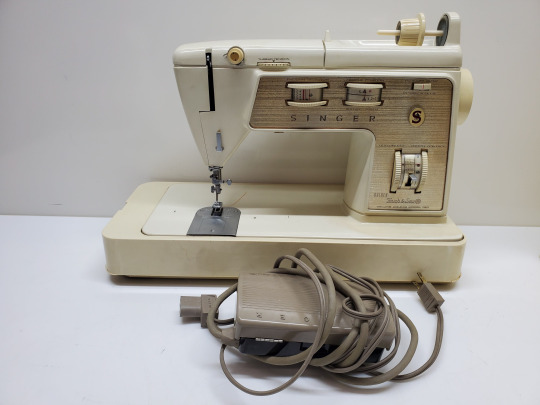
Any old black machine will be fine and very simple to use, and I think they look gorgeous, but they only straight stitch, so you won't be able to sew your own leggings on them. If you only want to make curtains, quilts, or bags or something, they will work fantastic for that. Just make sure they're serviced, as these things usually are not.
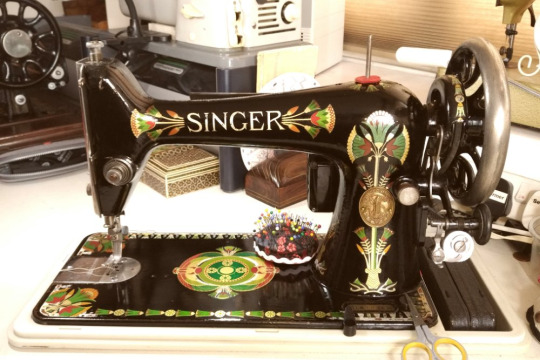
I'm going to talk to my younger, beginner self: Just because it's a used, older machine does not make it worse!
Even used modern plastic machines can work fine. It's rare that people are selling a machine as WORKING when it doesn't work. People tend to be honest about it. Usually they are selling it because they lost interest, it was given to them by a family member, or they just don't use it enough to keep around. Buying used is almost always the best, cheapest option for a beginner. Stop buying these cheapo gadgets on Amazon! They will only make you hate sewing machines.
140 notes
·
View notes
Note

Browsing an antiques store, and I found this Singer (possibly with the box underneath) for 100 dollars USD. Is that a good price?
I didn't see the notification for this, sorry!
Hm, that depends on what kind of shape it's in. If it does come with the box and is in good working order then I think it's a good price, but if it's just naked like that and needs to have a box or table sourced separately or is missing other pieces or needs bigger repairs then I think it's a bit much. Judging from the dust and rust I'd say it's the latter, and if it's sat in storage for years then cleaning and polishing can be a pretty big task all on its own.
I've only ever bought 2 sewing machines in my life so I'm sure more experienced people will comment with their input! But I paid 200 CAD for my Singer when I moved out of my parents place and it was newly refurbished.
The other machine I bought was my Pfaff that was $25 at an estate sale last year (on half off day or it would have been 50) and I think that was a fair price too because it was SUPER gummed up inside and I still need to finish unsticking it.
27 notes
·
View notes
Text

Crowded table to table, textile workers lean over their machines, sewing clothing in the Garment District, June 28, 1944. New York had always been the chief producer of clothing in the U.S. but it also became a fashion center during World War II, when Parisian fashion was unavailable.
Photo: Associated Press
#vintage New York#1940s#Garment District#sweatshop#sewing#sewing machines#June 28#28 June#garment factory#textile workers#ILGWU#vintage NYC
79 notes
·
View notes
Text




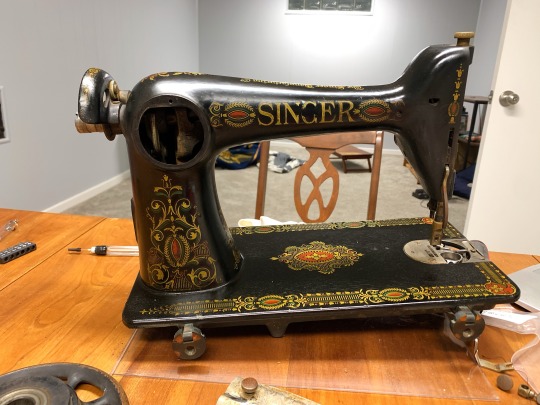
I bought this singer 66 at goodwill like 2 years and several states ago and it’s been collecting dust in my room without space for me to work on it but now!!! Is the time!!!!!
There was. A lot of grime removed so far and there is so much more to go but it’s a good start :’) wish me luck I am learning through the school of YouTube and hubris as usual
#sewing machines#vintage sewing machines#singer 66#cyanoupdates#look man idk I want to learn how to fix stuff so so so so bad
53 notes
·
View notes
Note
I didn't know they had children's sewing machines back then too! That's so cute! Do you know what they would have cost at the time, compared to an adult-sized one?
Pretty much anything a mom would have/do around the house came in a miniature version for little girls - sewing machines, wash tubs/boards, little china cabinets full of dishes, tiny cast iron stoves, etc., etc.
As for cost - much less generally, but it's a little hard to compare as most children's machines were just the machine and were hand cranked, while adult machines usually came with a cabinet and many had switched over to electric power by that time.
Children's machines in the fall/winter 1923 Sears range from about $15 to $100 when adjusted for inflation.
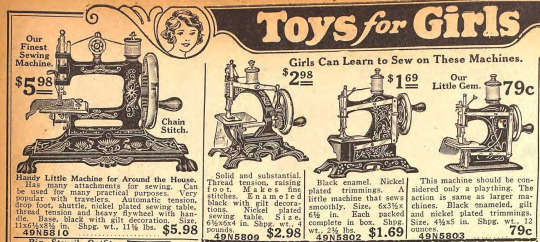
Whereas a cabinet-less adult sewing machine would run you closer to $700 - however it was an electric machine, so again, hard to compare.
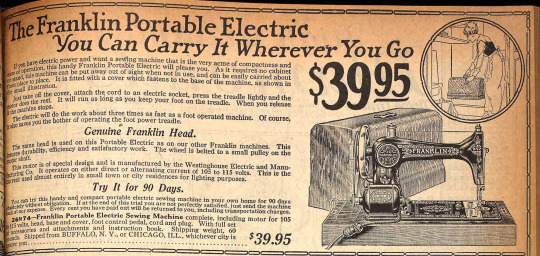
110 notes
·
View notes
Text
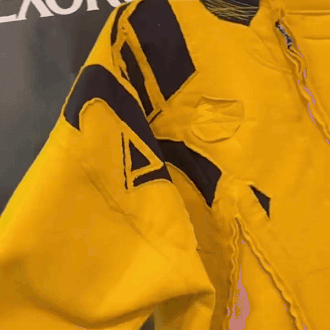
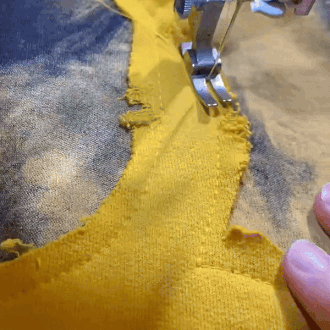
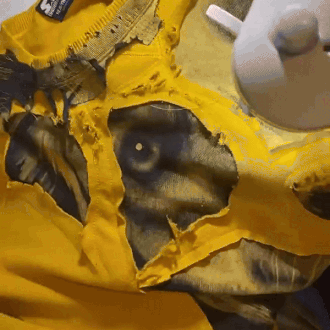
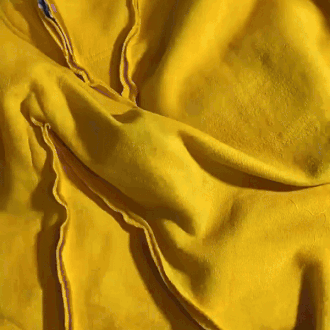
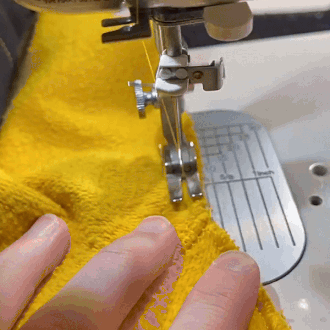
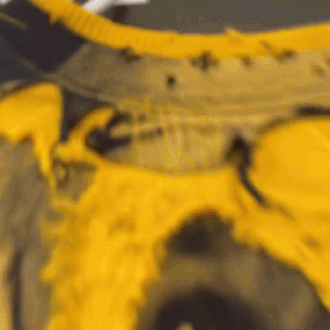
rittenonline on ig
#stim#diy fashion#clothes#sewing machines#sfw#yellow#black#white#silver#brown#dogs#fake animals#shirts#sweaters#diy clothes#punk#grunge#fabric#needles#hands#ishy gifs#postish
87 notes
·
View notes
Text
Sewing machine advice
Not the usual topic of this tumblr, but maybe share this around with sewing friends, if you have any?
I've only ever used old industrial machines and an American machine from the 70s. I need a new one, and I need to be able to buy it online in the EU. It seems like the choices are limited, and I'm having a hard time finding reviews that don't just reiterate the manufacturer's information. I want to know if it's any good!
Right now the best option I think I've found is the Viking HUSQVARNA Topaz 25.
I'd love a computerized machine that can do embroidery (and is able to import new designs) as well as normal sewing. Any suggestions or warnings are welcome.
8 notes
·
View notes
Text
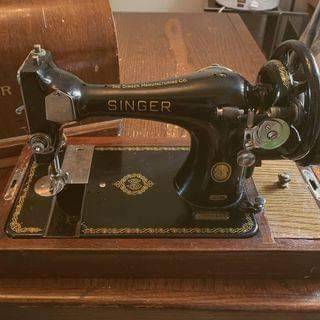
And here is my 1950s Singer sewing machine. This is also an old photo, but she was missing her bobbin, although I think she had nearly everything else. Like the others in my collection, she is a hand crank sewing machine.
#sewing machine#vintage sewing machine#sewing machines#sewing#antique sewing machine#crafts#cottagecore#cottagecore aesthetic#crafting#artists on tumblr#sewists of tumblr#antique#vintage#singer#singer sewing machine#1950s#grandmacore
111 notes
·
View notes
Text
i did NOT overspend by buying a vintage sewing machine tonight and i want credit for that
#it was a singer 503a#aka the rocketeer#it's so so pretty#i wanted it a lot#but it ended up going for twice my max bid#alas#covington-shenanigans gets personal#sewing machines
25 notes
·
View notes
Text
Remember to clean your sewing machine between projects. The reason you may be dealing with things like pinched seams and skipped stitches is your sewing machine needs some attention. Do not blow into the machine!!! You will only push lint deeper into the gears.
Remember to change your sewing needles. The seams may be messy because of this, as well as torn threads. Seeing needles are very inexpensive unless you buy them at a fabric store.i purchase mine from Organ Neddles Co, in packs of 100, for less than $20 USD online.
Remember to sharpen your scissors and change your rotary cutter blades. There are scissor sharpeners sold at fabric and craft stores, and they are very inexpensive. If you're unable to acquire one, take some aluminum foil, about 18 inches, fold it in half, and cut down the middle. Put the layers on top of each other and cut again. Do this one more time and cut it into thin strips. Voila, your blade is sharpened. There are rotary blade sharpeners as well, but they're more expensive. Save your used blades for sharpening you can do at a later date.
Your machine will thank you by not breaking and requiring parts be replaced.
Oh, and you do need to get your machine into a shop for full maintenance at least once a year. Folks who specialize in this may even be willing to do this in your home, especially for antique machines. Shops that are approved by retailers will cost significantly more than independent specialists. The only place approved by retailers here charges $150 USD per machine, regardless of whether it's manual or computerized. I went on the NextDoor app and asked for references for finding an independent specialist. It was $89 USD per machine, and he had them back to me in less than two weeks whereas the retailer approved shop gave me an ETA of four months. Give your machine the spa treatment it deserves. When it's returned to you, you will discover it's suddenly quieter, running smoothly, and working significantly better because these were things that built up so gradually, you didn't even notice.
You're welcome.
198 notes
·
View notes
Note
re ugly/cute industrial sewing machines, one of the ones they had at my college was shiny candy red and with a sort of round retro-vibes casing, i never got to use it but she haunts me ill never find another machine that cute 😔
ooh that sounds delightful! I've never seen a red sewing machine of any kind!
While most of the industrial machines I've used have been the same icky pebbled greige, there was a very old keyhole buttonholer at my previous job that was a nice light green. I think it might have been this kind. I have some photos of it somewhere but I don't know which hard drive they're on so I shan't look for them today.
It was a really nice machine. It does One Thing and that's buttonholes, and it had a little dial on the side showing how many it had made in its lifetime, and the number was in the millions.
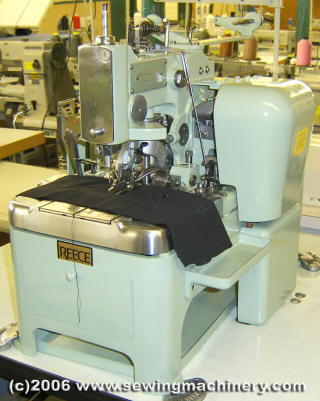
While the main sewing machine and the blind hemmer at my current job are also the same ugly colour, the serger is at least a nice green on the bottom.
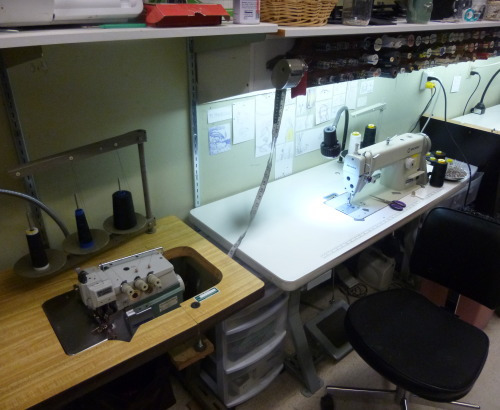
Still beige on the top though, alas.
47 notes
·
View notes
Text
let it be clear that all machines biologically crave blood, its just that sewing machines and miter saws are able to harvest it so much easier.
5 notes
·
View notes